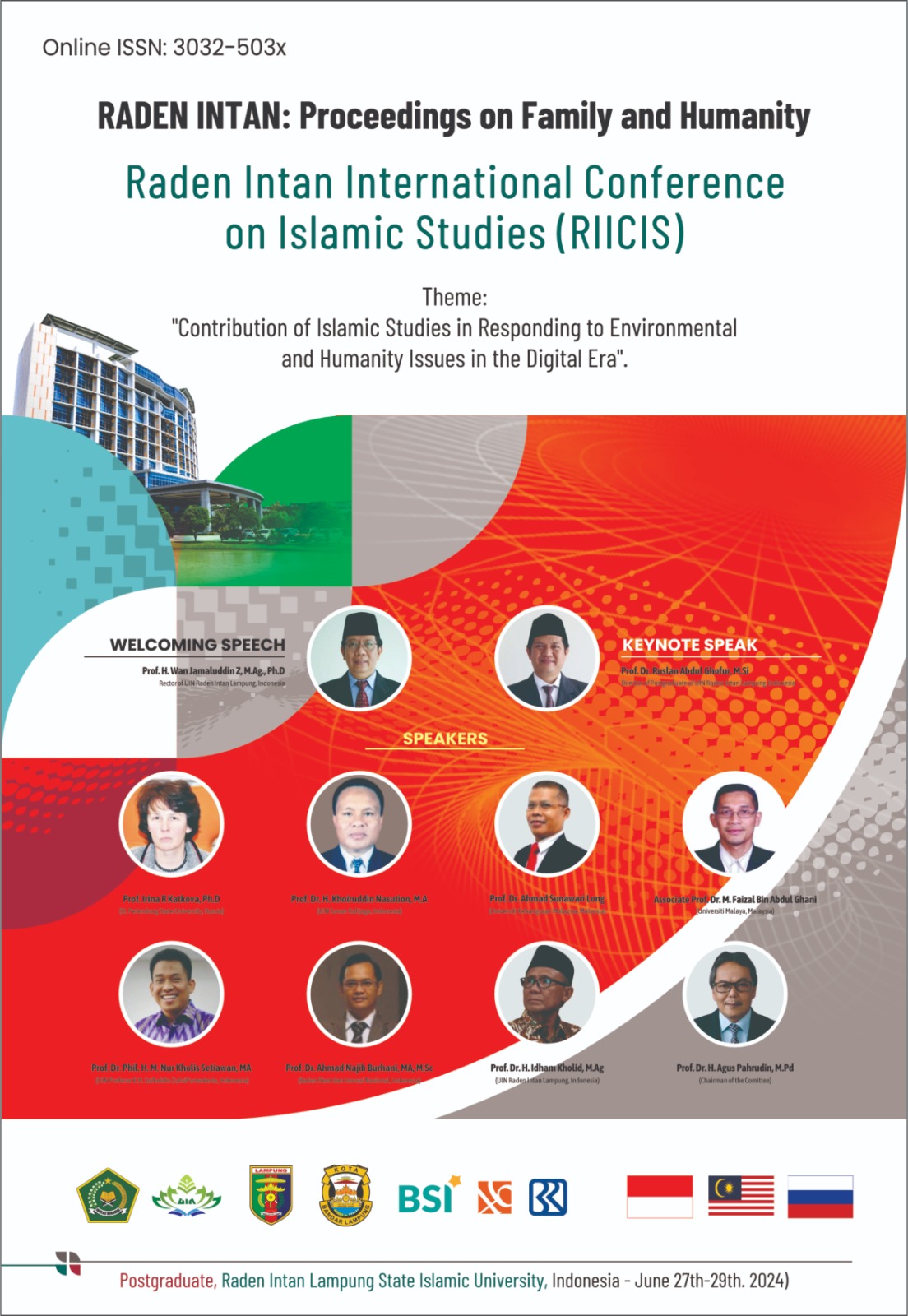Published 2025-01-01
Keywords
- Sufism,
- Science,
- Art,
- Islamic Mystic
Copyright (c) 2025 IRK, Ahamad Fauzan (Author)

This work is licensed under a Creative Commons Attribution 4.0 International License.
Abstract
Sufism in Islam is considered an ancient artifact due to its long-standing presence. Moreover, Sufism, known as mysticism in Islam, is considered illogical and irrelevant to modern science and art. This article aims to unveil the mystical concepts of Islam in modern science and art. This article uses a qualitative method, the type of article is a literature review, which analyzes in depth related to the literature of mystical conceptions in Islamic science and art. The approach used is a normative study. Data sources are obtained from literature sources related to mysticism in Islam. The research results show that, conceptually, Sufism as mysticism in Islam does not conflict with modern science and art. Sufism is able to adapt to the times, which is manifested in the activities taught by the Sufi order. (tarekat). Even more than that, Sufism is able to describe abstract concepts in modern science and art with its own language.
References
- Achmad Muzammil Alfan Nasrullah. (2021). Jalan Panjang Tasawuf: Dari Tasawuf Awal Hingga Neo-Sufisme. Spiritualita, 5(1), 26–41. https://doi.org/10.30762/spiritualita.v5i1.297
- Agus Riyadi. (2014). Tarekat Sebagai Organisasi Tasawuf (Melacak Peran Tarekat Dalam Perkembangan Dakwah Islamiyah). Jurnal At-Taqaddum, 6(2), 359–385.
- Alam, S. (2019). Cultural Fusion of Sufi Islam. Routledge.
- Alexander Max Bauer, M. I. M. (2020). Empirical Research and Normative Theory. Walter de Gruyter GmbH.
- Bagir, H. (2006). Buku Saku Tasawuf. Mizan.
- Baharudin and Nur Latifah. (2017). Peran Pendidikan Tarikat Qadiriyyah Wa Naqsabandiyah: Studi Kasus Di Pondok Pesantren Darul Falah Pagutan Mataram,”. Jurnal Tatsqif, 15(2), 223–241.
- Blair, S. S., Bloom, J. M., Blair, S. S., & Bloom, J. M. (2014). The Mirage of Islamic Art : Reflections on the Study of an Unwieldy Field The Mirage of Islamic Art : Reflections on the Study of an Unwieldy Field. December, 37–41. https://doi.org/10.1080/00043079.2003.10787065
- ed. Jane Turner. (1996). The Dictionary of Art,. Macmillan.
- Emily Herring, Kevin Matthew Jones, Konstantin S. Kiprijanov, Laura M. Sellers, E. (2019). The Past, Present, and The Future of Integrated History and Philosophy of Science. Routledge.
- Fathan Abidi, A. (2021). Kajian Literatur: Internalisasi Nilai-nilai Tasawuf dalam Ajaran Tarekat. Palapa, 9(2), 335–351. https://doi.org/10.36088/palapa.v9i2.1494
- Gitosaroso, M. (2015). Tasawuf Dan Modernitas (Mengikis Kesalahpahaman Masyarakat Awam Terhadap Tasawuf). Al-Hikmah, 10(1). https://doi.org/10.24260/al-hikmah.v10i1.550
- Harun Nasution. (1978). Islam Ditinjau dari Berbagai Aspeknya, Jilid II. Ul Press.
- Hill, J. (2021). Sufism Between Past and Modernity. In: Handbook of Contemporary Islam and Muslim Lives (M. (eds) Lukens-Bull, R., Woodward (ed.)). Springer Cham.
- Iqbal, M. (n.d.). The making of Islamic science. he Other Press.
- Irina R. Katkova. (2020). Sufi Authority in “Post Modern” Muslim Societies. Kalam, 14(1), 7.
- Jean-Louis Michon, R. G. (2006). Sufism: Love & Wisdom. World Wisdom, Inc.
- John Renard. (2016). Historical Dictionary of Sufism. Rowman & Littlefield.
- Julian Baldick. (2012). Mystical Islam An Introduction to Sufism. I.B. Tauris & Co Ltd.
- Kuhlthau, C. C. (1994). Teaching the Library Research Process. Scarecrow Press.
- Kurniawan Dwi Saputra. (2020). Memasyarakatkan Kesalehan: Dimensi Tasawuf dalam Etika Sosial Profetik Kuntowijoyo. ABHATS: Jurnal Islam Ulil Albab, 1(2), 25.
- Leo Tolstoy. (2010). On The Significance of Science and Art. The Floating Press.
- Lessnoff, M. (2007). Michael Lessnoff, Islam, modernity and science on Ernest Gellner and Contemporary Social Thought. Cambridge University Press.
- Lestari, P., Islam, U., Hasan, Z., Islam, U., Hasan, Z., Islam, U., & Genggong, Z. H. (2024). Tasawuf Di Era Modern : Tasawuf Sebagai Psikoterapi. 7(1), 169–175.
- Madden, H. (2015). Some Characteristics of Islamic. 33(4), 423–430.
- Milani, M. (2021). The Nature of Sufism. Routledge.
- Nasr, S. H. (1987). Islamic Art and Spirituality. State University of New York Press.
- Nasr, S. H. (2020). Living Sufism, terjemah Abdul Hadi W.M. IRCiSoD.
- Nasr S H. (1972). Esai-esai Sufi. State University of New York Press.
- Nata, A. (2018). Islam dan Ilmu Pengetahuan. Prenada Media.
- Nur, M., & Iqbal Irham, M. (2023). Tasawuf dan Modernisasi: Urgensi Tasawuf Akhlaki pada Masyarakat Modern. Substantia: Jurnal Ilmu-Ilmu Ushuluddin, 25(1), 107. https://doi.org/10.22373/substantia.v25i1.16851
- René Descartes. (2020). Diskursus & Metode Penerjemah: Ahmad Faridl Ma’ruf. IRCiSoD.
- Roger Gaetani. (2010). Introduction to Sufism: The Inner Path of Islam. World Wisdom, Inc.
- Ruth J. Nicholls, Peter G. Riddell, E. (2020). Insight into Sufism: Voices from the Heart. Cambridge Scholars Publishing.
- Sara Lawrence-Lightfoot, J. H. D. (1997). The Art and Science of Portraiture. Jossey-Bass.
- Schimmel, A. (1975). Mystical Dimensions of Islam. The University of North Carolina Press.
- Schmid, J. K. L. and T. (2022). The Practice of Innovating Research Methods. Organizational Research Methods, 25(2), 308.
- Suparjo, Muh. Hanif, D. I. S. (2021). Developing Islamic Science Based Integrated Teaching Materials for Islamic Education in Islamic High School. Pegem Journal of Education and Instruction, 11(4), 282–289. https://doi.org/10.47750/pegegog.11.04.27
- Trimingham J. Spencer. (1998). The Sufi Orders in Islam. Oxford University Press.
- Yusub, F. H. (2017). Interkoneksi Sufi Klasik dan Kontemporer (Mengenal Sufisme Islam. FIKROTUNA: Jurnal Pendidikan Dan Manajemen Islam, 6(1).

